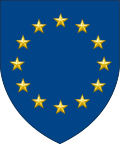European Union Military Committee
The Military Committee of the European Union (EUMC) is the body of the European Union's (EU) Common Security and Defence Policy that is composed of member states' Chiefs of Defence (CHOD). These national CHODs are regularly represented in the EUMC in Brussels by their permanent Military Representatives (MilRep), who often are two- or three-star flag officers.
| European Union Military Committee | |
|---|---|
 Coat of arms | |
| Active | December 2000–present |
| Allegiance | |
| Location | Brussels, Belgium |
| Website | europa.eu |
| Commanders | |
| High Repr. | Josep Borrell |
| Chairman | General Claudio Graziano |
| Insignia | |
| Flag |  |
| Chairman's arms |  |
The EUMC is under the under authority of the EU's High Representative (HR) and the Political and Security Committee (PSC).
History
The EUMC was formally established in December 2000 by the European Council of Nice, and is one of several defence and security-related bodies established as a result of the Helsinki Headline Goal, which was decided in December 1999.
Function
The EUMC gives military advice to the EU's High Representative (HR) and Political and Security Committee (PSC). The EUMC also oversees the European Union Military Staff (EUMS).
The relationship between the High Representative, the Military Staff and Military Committee as of November 2017:[1]
Colour key:
High Representative (a Vice-President of the Commission)
![]()
![]()
| High Representative | |||||||||||||||||||||||||||||||||||||||||||||||||||||||||||||||||
 Chairman EUMC | |||||||||||||||||||||||||||||||||||||||||||||||||||||||||||||||||
| Working Group | |||||||||||||||||||||||||||||||||||||||||||||||||||||||||||||||||
 Working Group/Headline Goal Task Force | Director General EUMS/ Director MPCC | ||||||||||||||||||||||||||||||||||||||||||||||||||||||||||||||||
| Legal advisor | Deputy Director General | Horizontal Coordination | |||||||||||||||||||||||||||||||||||||||||||||||||||||||||||||||
| Assistant Chief of Staff for Synchronisation | EU cell at SHAPE | EU Liaison at the UN in NY | Assistant Chief of Staff for External Relations | NATO Permanent Liaison Team | |||||||||||||||||||||||||||||||||||||||||||||||||||||||||||||
| Concepts & Capabilities Directorate | Intelligence Directorate | Operations Directorate | Logistics Directorate | Communications & Information Systems Directorate | Military Planning and Conduct Capability (MPCC)
| ||||||||||||||||||||||||||||||||||||||||||||||||||||||||||||
Role in command and control of missions
The EU command and control (C2) structure, as directed by political bodies which are composed of member states's representatives and generally require unanimous decisions, as of April 2019:[2]
- Liaison: Advice and recommendations Support and monitoring Preparatory work
| Political strategic level: | |||||||||||||||||||||||||||||||||
| ISS | EUCO Pres. (EUCO) | Chain of command | |||||||||||||||||||||||||||||||
| Coordination/support | |||||||||||||||||||||||||||||||||
| SatCen | CIVCOM | HR/VP (FAC) | |||||||||||||||||||||||||||||||
| INTCEN | HR/VP (PMG) | HR/VP (PSC) (******) | CEUMC (EUMC) | ||||||||||||||||||||||||||||||
| CMPD | DGEUMS (***) (EUMS) | ||||||||||||||||||||||||||||||||
| Military/civilian strategic level: | |||||||||||||||||||||||||||||||||
Dir MPCC (***) (MPCC) | JSCC | Civ OpCdr CPCC(*) | |||||||||||||||||||||||||||||||
| Operational level: | |||||||||||||||||||||||||||||||||
| MFCdr (****) (MFHQ) | HoM (*) | ||||||||||||||||||||||||||||||||
| Tactical level: | |||||||||||||||||||||||||||||||||
| CC(**) Land | CC(**) Air | CC(**) Mar | Other CCs(**) | ||||||||||||||||||||||||||||||
| Forces | Forces | Forces | Forces | ||||||||||||||||||||||||||||||
- *In the event of a CSDP Civilian Mission also being in the field, the relation with the Civilian Planning and Conduct Capability (CPCC) and its Civilian Operation Commander (Civ OpCdr), as well as the subordinate Head of Mission (HoM), are coordinated as shown.
- **Other Component Commanders (CCs) and service branches which may be established
- ***The MPCC is part of the EUMS and Dir MPCC is double-hatted as DGEUMS. Unless the MPCC is used as Operation Headquarters (OHQ), either a national OHQ offered by member states or the NATO Command Structure (NCS) would serve this purpose. In the latter instance, Deputy Supreme Allied Commander Europe (DSACEUR), rather than Dir MPCC, would serve as Operation Commander (OpCdr).
- ****Unless the MPCC is used as Operation Headquarters (OHQ), the MFCdr would be known as a Force Commander (FCdr), and direct a Force Headquarters (FHQ) rather than a MFHQ. Whereas the MFHQ would act both on the operational and tactical level, the FHQ would act purely on the operational level.
- *****The political strategic level is not part of the C2 structure per se, but represents the political bodies, with associated support facilities, that determine the missions' general direction. The Council determines the role of the High Representative (HR/VP), who serves as Vice-President of the European Commission, attends European Council meetings, chairs the Foreign Affairs Council (FAC) and may chair the Political and Security Committee (PSC) in times of crisis. The HR/VP proposes and implements CSDP decisions.
- ******Same composition as Committee of Permanent Representatives (COREPER) II, which also prepares for the CSDP-related work of the FAC.
Chairman
The EUMC is chaired by a General Officer, Admiral, or Air Officer of four-star level (i.e. NATO OF-9 equivalent) who is selected by the Chiefs of Defence and appointed by the Council of the European Union. For a term of three years the Chairman is the spokesperson for the EUMC, he participates in PSC meetings as appropriate, he is the military adviser to the High Representative of the Union for Foreign Affairs and Security Policy (HR) who heads the EEAS European External Action Service, he represents the primary point of contact with the Operation Commanders of the EU's military operations and he attends Council meetings with defence and security implications.[3]
See also
- Common Security and Defence Policy
- European External Action Service
- Military of the European Union
- Political and Security Committee
- European Union Military Staff
A similar committee also exists within the North Atlantic Treaty Organisation (NATO), and those countries which are members of both EU and NATO have in most cases chosen to use the same MilRep in both organisations.
References
External links
| Wikimedia Commons has media related to European Union Military Committee. |
- CSDP structure, instruments, and agencies, EEAS website
- Mai'a K. Davis Cross: "The Military Dimension of European Security: An Epistemic Community Approach." (2013) Millennium Journal of International Studies, 42(1): 45-64.